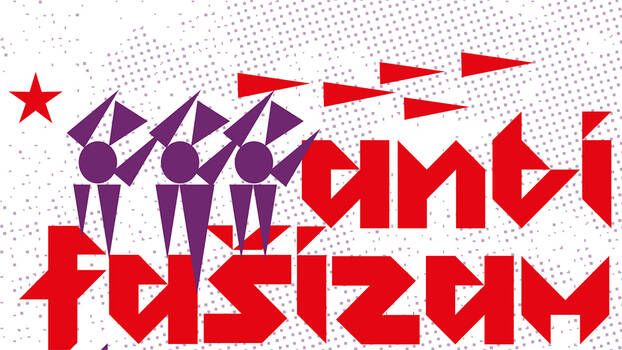
Antifascism as the Self-Defensive Monument, a new bi-lingual publication from the Rosa Luxemburg Foundation’s Southeast Europe Office in Belgrade, provides an intricate survey of the public artwork “Monument to Red Rijeka — The Self-Defensive Monument”, conceived by the artist Nemanja Cvijanović, whose sharp-minded and reflective gesture of agency undermines the current rise of nationalist violence in the region. This particular work presents a very precise point where the fascist and antifascist legacy confront one another and define Cvijanović’s gesture as relationality between society, politics, and art. This agency within Cvijanović’s work can also be considered as key to reading this publication.
Tevž Logar is an independent curator, editor, and writer who collaborates with various galleries, institutions, and publishers.
Vladan Jeremić is a project manager and editor at the Rosa Luxemburg Foundation’s Southeast Europe Office in Belgrade.
With a compelling range of contributions by various authors who examine the socio-political context in which Cvijanović’s artistic position operates, from a variety of perspectives, mostly grounded in their relation to antifascist, cultural, and art-historical theoretical discourse, the volume aims to show the narrative of the project from the beginning to the end and how this process reconsiders the status of the artwork and its role within society.
From this perspective, the publication does not position Cvijanovic’s agency only within the legacy of the anti-fascist movement but also tackles the role and value of the media image in our daily lives, and does so on both a formal and conceptual level. The circle of hyperproduction and hyperconsumption is even more vicious than it appears at first glance, because the media image, in order to meet the necessary distribution criteria, continuously “reflects” the needs of the economic and geopolitical panorama that is currently in force. Ultimately, the aim of this monographic publication is to analyse social models and ideologies (those which are less relevant to hegemonic social and political structures) and to identify and propose aspects or specific ideas that may still be, or could become, applicable to today’s antifascist struggles.
The volume is introduced by three essays by the authors Dragan Markovina, Ivana Bago, and Stefano Taccone. Through an analysis of local, national, and international media, Markovina defines the role of the media in creating an image of modern society, how certain phenomena are detected and processed in the media, and how commercial, public, and non-profit media encourage the growth of conservative tendencies and influence the accelerating fascization of society.
The volume continues with a text by Ivana Bago, who defines Nemanja Cvijanović’s action not only as part of the antifascist movement, but also as its synecdoche, which, in reducing its symbolizing resources to a hyperbolized sign of the red star, embodies the achievements but also the contradictions of artistic practices dealing with the historicization of Yugoslavia and its socialist past. While Markovina and Bago remain within the context of a local and regional understanding of Cvijanović’s action, Stefano Taccone positions it within the context of the international system of contemporary art. This gesture highlights the excessive power of the market and its utilization of politically and socially engaged artistic practices. In light of this problem and with the intention of elaborating upon existing mechanisms of power, he proposes the institution of the Biennale di Venezia as a case study and analyses the strategy of exhibition politics behind it.
The central part of the volume comprises four shorter essays that do not provide in-depth analysis of Cvijanović’s artistic intervention but rather the socio-political context in which his intervention was made possible. As such, they serve as four different positions that direct the reader towards an understanding of this particular artistic gesture. Following his latest research into the causes and reasons for the collective amnesia that cloaks the importance of the Yugoslav partisan struggle against fascism during World War II, referring to Cvijanović’s action, Gal Kirn deconstructs the continued politics of anti-memory in a contemporary moment when fascism seems once again ascendant. Kirn’s thought relates to the texts of Michał Kozłowski, who exposes the mechanisms inherent to fascism in our time and proves that fascism is not exactly being rehabilitated. Rather, it is being relativized, normalized, and, most importantly, absorbed into dominant and existing ideologies.
While Kirn and Kozłowski analyse particular phenomena related to fascisms and their legacy, Katarina Peović’s contribution defines the problem posed by revisionist Resolutions of the European Parliament, condemning the equation of two European totalitarianisms. In more practical terms, the essay discloses how today’s neofascist groups can utilize documents that were approved and voted for by both centre-left and centre-right parliamentarians.
The textual section concludes with a reflection from Srećko Pulig, who emphasizes the differences and similarities between historical fascism and today’s post-fascism. His analysis of what fascization is today and what today’s antifascism is like helps us in conceiving guidelines for an effective, offensive and politically incorrect anti-fascism.
As a structure, this book is designed as a visual essay that allows for a critical reading of the work “Monument to Red Rijeka — The Self-Defensive Monument”, by being “grounded” in various theoretical case studies. It is important to understand that the presented artwork should not be perceived exclusively through the act of “erecting” the monument but rather through span surrounding the work and how it was perceived in the wider public sphere.
Without a doubt, Cvijanović’s intervention should be seen as a social sculpture that goes further than its materialization in the form of the red star. Consequently, the visual narrative of the publication is arranged in a linear way and functions as a juxtaposition between the analysis of local, regional, and international media, social networks, documentation of official announcements and comments from the Croatian parliament to local sessions of city councils, and the actual visual documentation of the project.
The visual material was organized, selected, and structured in a dialogue between Davor Konjikušić, Nemanja Cvijanović, and Mario Aničić, who also developed the design concept for the publication.